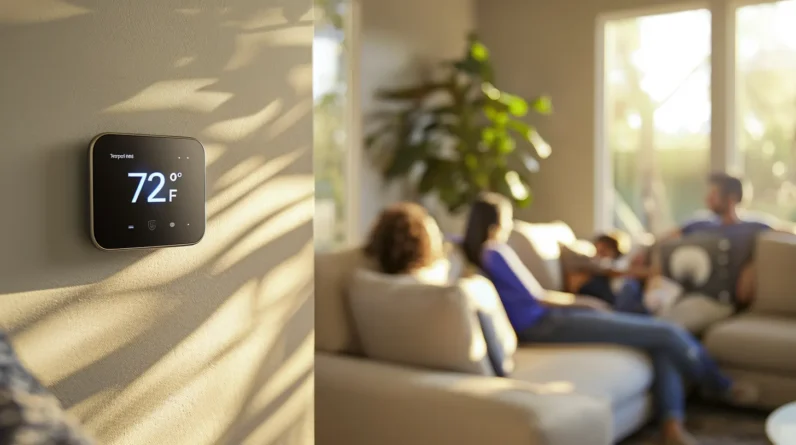
Smart thermostats revolutionize how we control our family living spaces through advanced sensors, machine learning, and wireless connectivity. We’ll achieve precise temperature control within ±1°F while cutting energy costs by 10-15% annually. Leading models like the Nest Learning Thermostat and Ecobee SmartThermostat adapt to our routines within days, offering multi-room sensing and smartphone control. Installation typically takes under 45 minutes, and with utility rebates of $50-$100, the $150-$300 investment pays for itself through monthly savings of $20-$30. The deeper we explore these intelligent climate systems, the more control and comfort we’ll discover for our homes.
Understanding Smart Thermostat Technology
Smart thermostats represent a significant leap forward in home climate control technology, combining advanced sensors, machine learning algorithms, and wireless connectivity. These devices monitor our home’s temperature patterns, humidity levels, and occupancy through an array of integrated sensors.
We’ll find that modern smart thermostats utilize AI-powered learning capabilities to adapt to our daily routines. They analyze when we’re home, our preferred temperatures at different times, and even local weather data to optimize HVAC performance. Through WiFi connectivity, we can control these systems remotely via smartphone apps, enabling real-time adjustments and monitoring.
The technology incorporates multiple temperature sensors throughout our living spaces, creating precise comfort zones while minimizing energy waste. Most units also track energy consumption patterns, providing detailed usage reports that help us understand and improve our home’s efficiency.
Key Features and Benefits
Today’s leading smart thermostats deliver an extensive suite of features that optimize both comfort and energy efficiency. We’ll find advanced motion sensors that detect occupancy patterns, automatically adjusting temperatures when rooms are empty. These systems integrate learning algorithms that analyze our daily routines, creating personalized schedules that maximize energy savings while maintaining ideal comfort levels.
We can access real-time energy consumption data through mobile apps, enabling us to track usage patterns and identify opportunities for optimization. Most units offer multi-zone control, allowing different temperature settings throughout our home. Remote access capabilities let us adjust settings from anywhere, while integration with voice assistants provides hands-free control. The smart scheduling features adapt to seasonal changes and can automatically switch between heating and cooling modes based on outdoor temperature data.
Popular Smart Thermostat Models
With these advanced features in mind, let’s examine several leading models that dominate the residential smart thermostat market. The Nest Learning Thermostat (3rd gen) offers machine learning capabilities, adapting to our routines within a week, while maintaining precision control within ±1°F. Ecobee’s SmartThermostat delivers multi-room sensing through remote sensors and integrates with major voice assistants.
The Honeywell Home T9 excels with its 200-foot range sensors and individual room prioritization, while Emerson’s Sensi Touch provides best-in-class humidity control and geofencing capabilities. For budget-conscious homeowners, the Amazon Smart Thermostat delivers core functionality at half the price of premium models. Each of these units supports mobile app control, energy usage reporting, and HVAC system monitoring, though their specific algorithms and sensor accuracies vary.
Installation and Setup Guide
Most smart thermostat installations require just 30-45 minutes when following manufacturer guidelines carefully. We’ll begin by turning off power at the circuit breaker and removing the old thermostat’s faceplate to expose the wiring. Let’s take a photo of the existing wire configuration and label each wire before disconnecting them.
Next, we’ll mount the new smart thermostat’s baseplate, ensuring it’s level, and connect the labeled wires to their corresponding terminals. We can now attach the display unit and restore power. The thermostat will guide us through Wi-Fi setup and system configuration via the touchscreen interface. We’ll download the manufacturer’s app, create an account, and pair our device. The final step involves programming our preferred temperature schedules and exploring advanced features like occupancy sensing and weather integration.
Energy Savings and Cost Analysis
Smart thermostats deliver measurable financial returns through systematic temperature optimization and usage pattern analysis. We’ve found that homeowners typically save 10-15% on heating and cooling costs within the first year of installation. These savings stem from automated temperature adjustments, occupancy detection, and learning algorithms that fine-tune HVAC operation.
Let’s break down the cost-benefit analysis: While smart thermostats range from $150-$300 upfront, we’ll recover this investment through monthly utility savings of $20-$30 on average. The device’s ability to generate detailed energy reports helps us identify peak usage periods and optimize settings accordingly. Additionally, many utility companies offer rebates of $50-$100 for installing ENERGY STAR certified smart thermostats, further accelerating our return on investment.
Conclusion
Smart thermostats have revolutionized our home climate control like a skilled orchestra conductor directing each room’s perfect temperature. We’ve explored how these intelligent devices optimize comfort while slashing energy costs through advanced scheduling, learning algorithms, and remote accessibility. By upgrading to smart thermostats, we’re not just controlling temperature – we’re maximizing HVAC system efficiency, reducing our carbon footprint, and creating precisely calibrated living environments for years to come.







